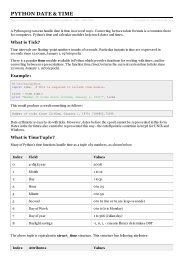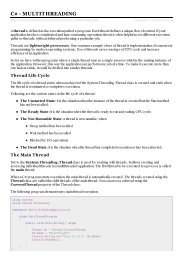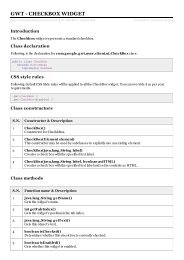Download Scala Tutorial (PDF Version) - Tutorials Point
Download Scala Tutorial (PDF Version) - Tutorials Point
Download Scala Tutorial (PDF Version) - Tutorials Point
Create successful ePaper yourself
Turn your PDF publications into a flip-book with our unique Google optimized e-Paper software.
CHAPTER<br />
20<br />
<strong>Scala</strong> Extractors<br />
An extractor in <strong>Scala</strong> is an object that has a method called unapply as one of its members. The purpose<br />
of that unapply method is to match a value and take it apart. Often, the extractor object also defines a dual<br />
method apply for building values, but this is not required.<br />
Following example shows an extractor object for email addresses:<br />
object Test {<br />
def main(args: Array[String]) {<br />
println ("Apply method : " + apply("Zara", "gmail.com"));<br />
println ("Unapply method : " + unapply("Zara@gmail.com"));<br />
println ("Unapply method : " + unapply("Zara Ali"));<br />
}<br />
// The injection method (optional)<br />
def apply(user: String, domain: String) = {<br />
user +"@"+ domain<br />
}<br />
}<br />
// The extraction method (mandatory)<br />
def unapply(str: String): Option[(String, String)] = {<br />
val parts = str split "@"<br />
if (parts.length == 2){<br />
Some(parts(0), parts(1))<br />
}else{<br />
None<br />
}<br />
}<br />
This object defines both apply and unapply methods. The apply method has the same meaning as always: it turns<br />
Test into an object that can be applied to arguments in parentheses in the same way a method is applied. So you<br />
can write Test("Zara", "gmail.com") to construct the string "Zara@gmail.com".<br />
The unapply method is what turns Test class into an extractor and it reverses the construction process of apply.<br />
Where apply takes two strings and forms an email address string out of them, unapply takes an email address and<br />
returns potentially two strings: the user and the domain of the address.<br />
The unapply must also handle the case where the given string is not an email address. That's why unapply returns<br />
an Option-type over pairs of strings. Its result is either Some(user, domain) if the string str is an email address<br />
with the given user and domain parts, or None, if str is not an email address. Here are some examples:<br />
TUTORIALS POINT<br />
Simply Easy Learning

















